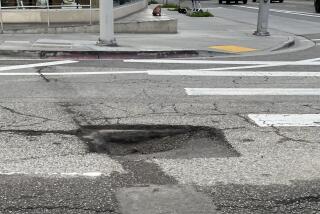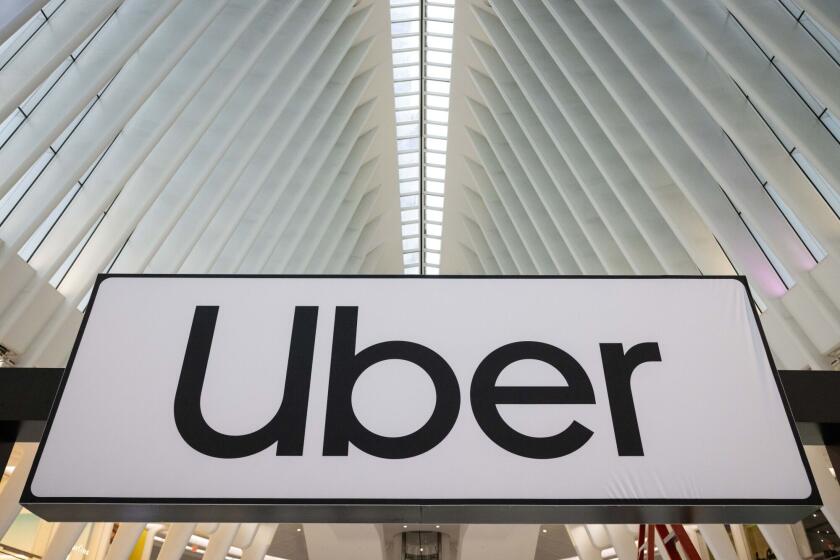Absent Mayor Should Attend to Santa Ana’s Pedestrian Crisis
- Share via
Where is Santa Ana Mayor Miguel Pulido?
People have been dying on the streets of his city, which holds the gruesome distinction of being the most dangerous place for pedestrians in Southern California. Men on their way to work are being toppled from their bikes. Women are being mowed down in crosswalks. Children are being killed and injured on their way to school.
The problem is so serious that state legislators held hearings last month on the troubling traffic trend. The Sacramento lawmakers convened in Pulido’s town, ready to study causes, explore answers and
consider possible solutions.
So, where was Mayor Pulido?
The mayor chose not to attend the hearing, which was chaired by Assemblyman Lou Correa (D-Anaheim). Pulido told me this week that he gave Correa this justification for his absence: “I can come and speak to you as a layperson, but I think, if you’re after information and results, you’re going to get better answers from public works and police [officials].”
The emissaries who went in the mayor’s stead told lawmakers the city needs more money to find effective remedies to end the pedestrian slaughter. Of course, the mayor was not there in person to press the city’s case for additional resources.
In fact, Pulido has been virtually silent on the pedestrian crisis, content to work behind the scenes or let others take the lead in trying to find ways to protect residents of his city.
Some say it’s not his style to go public on such matters. Pulido has certainly been out in front on issues that apparently place higher on his agenda, such as limiting the number of people who can live in Santa Ana homes. What’s undeniable is that the mayor has shown a clear lack of initiative on the pedestrian safety issue.
“Anything that will help, I’m willing to do,” Pulido said. “I’m just not willing to give anyone false hope [about solutions]. . . . A lot of times, I think you can do more by not being out in the public eye on every single issue.”
On this issue, Pulido said he has had several discussions with the police chief, the head of public works and the city manager. But the problem is more complicated than it appears, and proposing a plan prematurely can mislead people into a sense of false security.
“If I had a great solution,” he said, “I’d be out all over it.”
Most of the victims of pedestrian accidents have been Mexican immigrants, like the mayor himself. Latino youngsters are especially vulnerable--11 of the 15 children killed countywide by cars in 1997 were Latinos.
It’s easy to see why the statistics are so tilted. Latinos are the ones doing most of the walking. In poorer cities like Santa Ana, people are forced to get around on foot. And in a culture where the car is king, walking can be dangerous.
On Thursday, after returning from Seattle, where he attended the controversial meeting of the World Trade Organization, Pulido told me he intends to record public service announcements to promote pedestrian safety. A key solution, he believes, is to get people to use crosswalks.
But that’s too little, too late. Even the mayor’s admirers, like attorney Al Amezcua, are disturbed by the city’s failure to confront the problem more aggressively.
“I can’t think of a higher priority than losing life, if it happens in our city and right in front of our eyes,” said Amezcua, who witnessed a man being hit by a car on Broadway right outside his office window. “If the victims had been children of the established residents, the influential people north of 17th Street, you bet you’re sweet bippie you would have heard some outcry about taking some additional measures.”
Amezcua says he often hears from critics who complain about the mayor’s aloofness. He’s even talked to the mayor about his image problem, urging him to be more outspoken on issues, including pedestrian safety.
Still, Amezcua defends Pulido as a hard-working mayor who cares passionately about his city. He should not be discounted because he operates outside the public spotlight.
Says Amezcua: “A lot of times, fortunately or unfortunately, Miguel likes it that way.”
I’ve observed Pulido since 1994, when he became the first Latino elected mayor of Orange County’s largest city. He’s a man with ample communication skills, a booming voice and towering self-confidence. And he’s fluent in three languages, English, French and Spanish, an obvious advantage in reaching the city’s Mexican majority.
Yet the mayor has not managed to use his personal strengths and his powerful platform to articulate his own vision for the city, distinct from the conservative agenda at City Hall that stresses infrastructure and enforcement above social services.
After four years in office, it’s hard to say what Miguel Pulido stands for. An engineer by training, he has preferred the role of quiet technocrat to charismatic leader.
The big drawback to his leadership style: The city has problems that might respond to a show of charisma from the man at the top. Santa Ana’s high rate of pedestrian deaths is one of them.
In May, The Times revealed startling statistics about Blood Alley, a one-mile stretch of West 1st Street where nearly one fourth of all pedestrian deaths occurred over the last three years. Since 1995, five pedestrians lost their lives and six have been injured on that risky road between Bristol and Fairview.
Those tragedies took place within 10 blocks of Pulido’s muffler shop, on 1st near Main Street. But the mayor saw fit to ignore reporter Rich Marosi’s repeated requests for comment on that story.
By not talking publicly, Pulido missed yet another opportunity to lend his voice to the call for solutions. The mayor should have used his office as a bully pulpit to make the issue a higher priority at City Hall.
If he had done that earlier, maybe city staff would not have waited to learn about Blood Alley in the newspaper. Instead, officials had to admit they were not aware of the accident clusters discovered by the Times analysis.
The city, in fact, had blindly raised the speed limit along 1st Street, making it even more dangerous for people to cross its six lanes of speeding traffic.
But in Floral Park . . .
So far, the city’s main response to the pedestrian problem has been to crack down on jaywalkers and reckless motorists. Some pedestrians are even being ticketed for seeking refuge on medians that divide the city’s wide avenues and busy boulevards.
“I don’t understand what the City Council is doing down there,” says Gloria Ohland, a Los Angeles safety advocate with the Surface Transportation Policy Project. “I think it’s inane. Instead of trying to make the streets safer for people, they’re just trying to discourage people from walking. It’s backward.”
The city’s traffic strategy has been quite different in those neighborhoods north of 17th, richer and whiter than the rest of the city. Drive around nice neighborhoods like Floral Park--if you can find your way in. You’ll hit traffic barriers blocking your passage on certain streets, like Ross and Santa Clara. They were put there by the city to reduce vehicular traffic through those areas, despite heated controversy but with Pulido’s support.
That’s the way it goes in Santa Ana. The people with clout get protective barriers; the migrant masses get expensive citations.
This is not the first time people have been perplexed by the policies that get priority in Santa Ana, a predominantly Latino city run by a predominantly white elite. Often, officials have pursued pet projects that seem at odds or out of touch with the needs of the city’s working-class majority.
In recent years, the city has limited the number of people per household, restricted the movements of produce vendors, banned parking in crowded neighborhoods, clamped down on yard sales and flea markets and cut back on public pay phones. Perhaps that’s been Santa Ana’s secret pedestrian safety strategy: Save people from themselves by forcing them off the streets.
An Image Problem
And just this week, the city pushed yet another restrictive ordinance, limiting the number of check-cashing businesses allowed downtown, a prime Latino shopping area. Critics see this new law as more official hostility to an immigrant lifestyle, since mostly immigrants use the check-cashing services.
But Mayor Pulido was front and center in the press supporting the new ordinance. Too many such businesses, the line from City Hall goes, are bad for the image of Santa Ana.
“The image of the city.” That’s code talk in Santa Ana for anything that’s not too Mexican. The Artists Village fits the image of the city, and Pulido has been very vocal in his support of the attempt to gentrify downtown with coffeehouses and trendy restaurants. At the same time, he was a very visible proponent of the city’s attempt to limit housing density, a repressive move that drew a successful lawsuit from Hermandad Mexicana Nacional, the immigrant advocacy group.
As a result, Pulido is perceived in some quarters as the Establishment Mayor, not the People’s Mayor.
“It’s mind-boggling because he was an immigrant himself,” said Sam Romero, a downtown shopkeeper and veteran neighborhood leader. “He just doesn’t remember what it took to get off the ground.”
Maybe the mayor needs to walk more often.
More to Read
Sign up for Essential California
The most important California stories and recommendations in your inbox every morning.
You may occasionally receive promotional content from the Los Angeles Times.













